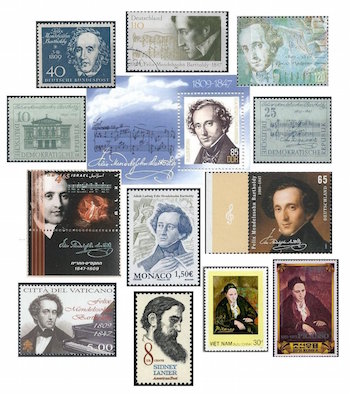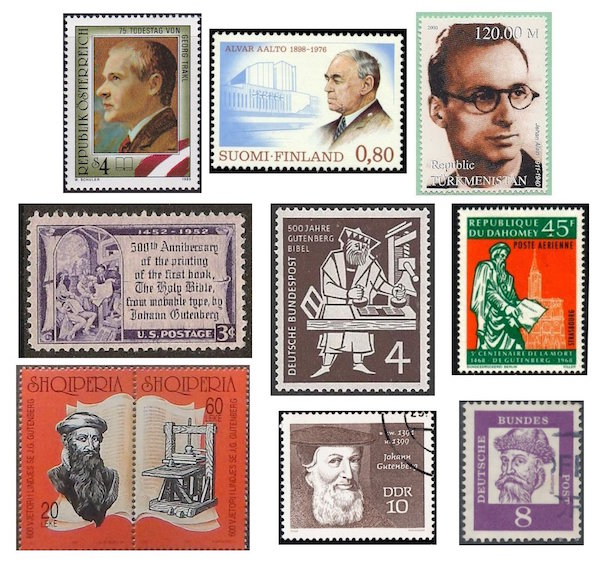The Arts on the Stamps of the World — February 3
An Arts Fuse regular feature: the arts on stamps of the world.

By Doug Briscoe
Just three days after my big Schubert spread, I present my complete Felix Mendelssohn collection for his 208th birthday. Also born on this date were Sidney Lanier, Gertrude Stein, Carl Dreyer, Norman Rockwell, James Michener, and six more artists, plus we offer a tribute to Johannes Gutenberg.
There are at least as many more Mendelssohn stamps in existence as the ones I show here. At the center we see issues from the former East Germany—the minisheet from 1984 is bracketed by a pair of stamps from 1959, the one at left depicting the Leipzig Gewandhaus, although the building shown was not erected until 1884, many years after Mendelssohn’s death. (The building Mendelssohn knew had been put up in 1781.) More recent stamps come from Israel (1996—the quotation from Elijah is easily recognizable because of the text), Monaco, Germany, and the Vatican (these last three from 2009 for the bicentennial).
American poet Sidney Lanier (February 3, 1842 – September 7, 1881) was born in Macon, Georgia, took an interest in the flute as a child and, many years later, became first flute with the Peabody Orchestra in Baltimore. In his youth, however, he served in the signal corps in the Confederate Army and was captured while working on a British blockade runner. While incarcerated, he contracted tuberculosis, from which he suffered for the rest of his life. Besides his poetry, which often makes use of Southern dialects, he wrote one novel. His poems have been set to music by several of the important postbellum American composers: Chadwick, Henry Hadley, Dudley Buck, and Griffes, as well as by later figures such as Vaughan Williams.

Both of the stamps I could find for Gertrude Stein (1874 – July 27, 1946) were meant to honor not her, but rather Picasso through his famous portrait of her. Even odder, perhaps, is the provenance of these stamps: Vietnam and North Korea! Anyway, Stein collaborated with Virgil Thomson as librettist on Four Saint in Three Acts and The Mother of Us All. Thomson set several other Stein poems as songs (as did Leonard Bernstein, Gunther Schuller, Ned Rorem, David Diamond, Vivian Fine, Paul Bowles, et al.), and one of Thomson’s Portraits for solo violin is titled “Miss Gertrude Stein as a Young Girl.”
Carl Theodor Dreyer (1889 – 20 March 1968), whose name is usually seen as Carl Th. Dreyer, was perhaps the finest Danish film director and one of the finest from anywhere. One of his greatest creations is the stunning The Passion of Joan of Arc (1928) (keep an eye out for Michel Simon as one of the monks). His output was relatively small, only 14 features and eight shorts. Between Vampyr (1932) and Day of Wrath (1943) he made only one short, and another decade passed between the making of The Word (1955) and his final film Gertrud (1964).
Norman Rockwell (1894 – November 8, 1978) is a popular subject on stamps of the world. Not only has he been honored personally on a US issue from 1994, but his heartwarming illustrations also appear on a number of other US stamps, the first (I think) being a 1963 City Mail Delivery stamp. His work was also used for a Tom Sawyer stamp from 1972. I also include just a couple of many international examples from the Cook Islands and Lesotho.
James Michener (1907 – October 16, 1997) was adopted in infancy and never knew his biological parents. He taught English, married the first of his three wives, and served in the Navy in WWII, an experience that resulted in his Tales of the South Pacific, for which he won a Pulitzer in 1948. This work served as the basis for the hit musical South Pacific. Michener went on to write expansive, throughly researched novels focusing on particular places: Hawaii (1959), Chesapeake (1978), Poland (1983), Texas (1985), Alaska (1988), and Caribbean (1989), to cite the main examples. A notable philanthropist, Michener donated over $100 million to educational and cultural organizations, more than $37 million to the University of Texas at Austin.

I’ll treat our remaining subjects in the order of their birth (although the stamp for architect Jan Santini Aichel is placed at far right in the third row purely for aesthetic purposes). Aichel (1677 – 7 December 1723) was born in Prague with a birth defect that left half his body paralyzed. Unable to follow his father’s career as a stonemason, Aichel studied painting and architecture, travelling to his grandfather’s homeland of Italy (whence comes the name Santini). Setting up on his own, Aichel was successful enough to finance his own construction company. Through his second marriage he became ennobled. His works in the Baroque Gothic style include a number of churches, one of them the Church of Saint John of Nepomuk in the town of Zelená Hora (now a World Heritage Site), shown on this Czech stamp from 1996.
Johann Georg Albrechtsberger (1736 – 7 March 1809) is probably most famous for having said that Beethoven would never do anything respectable: “was Ordentliches.” In fairness, the word “ordentlich” has many meanings, including “orderly,” “ordinary,” “proper,” etc. Certainly Beethoven did not do much that was “ordinary,” but the consensus is that Albrechtsberger did not mean it as a compliment. His other students included Hummel, Moscheles, Reicha, and Mozart’s son Franz Xaver. The stamp was issued by Austria for Albrechtsberger’s sesquicentennial in 1986.
Annette Kolb (1870 – December 3, 1967) was born to a German architect father and a French pianist mother and all her life strove to bridge those two great cultures. An outspoken pacifist, she was exiled to Switzerland as a result of her condemnation of the First World War. Her novels were admired by Rilke and banned during the Third Reich. Kolb emigrated to Paris in 1933 and took French citizenship in 1936, but fled to New York during the Second War. Besides her fiction, she wrote biographies of Mozart and Schubert and a book on the relationship between Bavarian King Ludwig II and Wagner. She won the last annual Goethe Prize in 1955 (since when it has been awarded only once every two or three years) and died in Munich.
Georg Trakl (1887 – 3 November 1914) bears a number of similarities with Annette Kolb. His parents were of different ethnicities (Hungarian and Czech), he grew up learning French (from his nanny) as well as his native German, and there was a musical connection, too, as Trakl’s sister Grete was a piano prodigy. He began writing poetry while still a schoolboy but studied pharmacology. This enabled him to gain access to drugs that would later claim his life. Ludwig Wittgenstein supported him financially so that Trakl could continue writing. With his knowledge of pharmacy, he was sent in a medical capacity to the Eastern Front in World War I and attempted suicide with a pistol, shortly thereafter succumbing to a cocaine overdose at age 27. His sister, too, would take her own life three years later, aged 26. Considered an important Austrian Expressionist poet, his works were set by such composers as Anton Webern, Paul Hindemith, and, more recently, Peter Maxwell Davies and Hans Werner Henze.

Best known as an architect, Finnish designer Alvar Aalto (1898 – 11 May 1976) also worked in sculpture and painting. Most of his buildings are in Finland, but he also designed Baker House at MIT, the Institute of International Education in New York City, and the opera house in Essen, Germany, among others. There are also significant furniture designs as part of Aalto’s Gesamtkunstwerk philosophy. Shown on the stamp is Finlandia Hall in Helsinki (completed 1971).
The world lost a gifted composer and musician when Jehan Alain, the brother of the great French organist Marie-Claire Alain, was killed in 1940, just two days before Marshal Pétain’s France signed the armistice with Germany. He left us a substantial body of striking music for the organ. His and his sister’s interest in that instrument was hardly surprising, given that their father was himself an organist and composer (as was their brother Olivier) besides being an organ builder. Jehan, who was born on 3 February 1911, went on to study under Marcel Dupré and Paul Dukas, winning awards for harmony and composition. He was organist of Saint-Nicholas de Maisons Laffitte in Paris. Decades later, his sister gave him a splendid memorial by recording his complete works for the organ. The stamp, unexpectedly, is a product of Turkmenistan!
Just a brief mention of Johannes Gensfleisch zur Laden zum Gutenberg, born about 1398, who died on this date in 1468. His enormous significance as the first printer in Europe to use movable type is reflected in a great many stamps from all over the world, including even one from the United States, which tends to be rather reticent when honoring foreigners philatelically.
A graduate of the University of Massachusetts with a B.A. in English, Doug Briscoe worked in Boston classical music radio, at WCRB, WGBH, and WBUR, for about 25 years, beginning in 1977. He has the curious distinction of having succeeded Robert J. Lurtsema twice, first as host of WGBH’s weekday morning classical music program in 1993, then as host of the weekend program when Robert J.’s health failed in 2000. Doug also wrote liner notes for several of the late Gunther Schuller’s GM Recordings releases as well as program notes for the Boston Classical Orchestra. For the past few years he’s been posting a Facebook “blog” of classical music on stamps of the world, which has now been expanded to encompass all the arts for The Arts Fuse.
